11 Types Of Marketing Strategies That Will Definitely Work For Your Company

When you ask ChatGPT to write an intro to something in a friendly manner, it always begins with “welcome to the exciting world” of something. However, it would be absolutely right to call marketing a world! It is huge and versatile but exciting nonetheless.
So, welcome to the exciting world of marketing, folks! In this piece, we’ll talk about types of growth strategy in marketing. What they are, where they are applicable, what differences they have, and how to use each. Thrilled yet?
Let’s get to it!
What is a marketing strategy?
Marketing strategy is a well-thought-out plan that guides you on how to advertise your services, brand, or product. Moreover, it covers ways how to effectively reach the target audience and spread the word about your business.
Different types of marketing strategy serve as a roadmap in the fluctuating business world. With a marketing strategy in place, you can reach your target audience, grab their attention, and deliver your values.
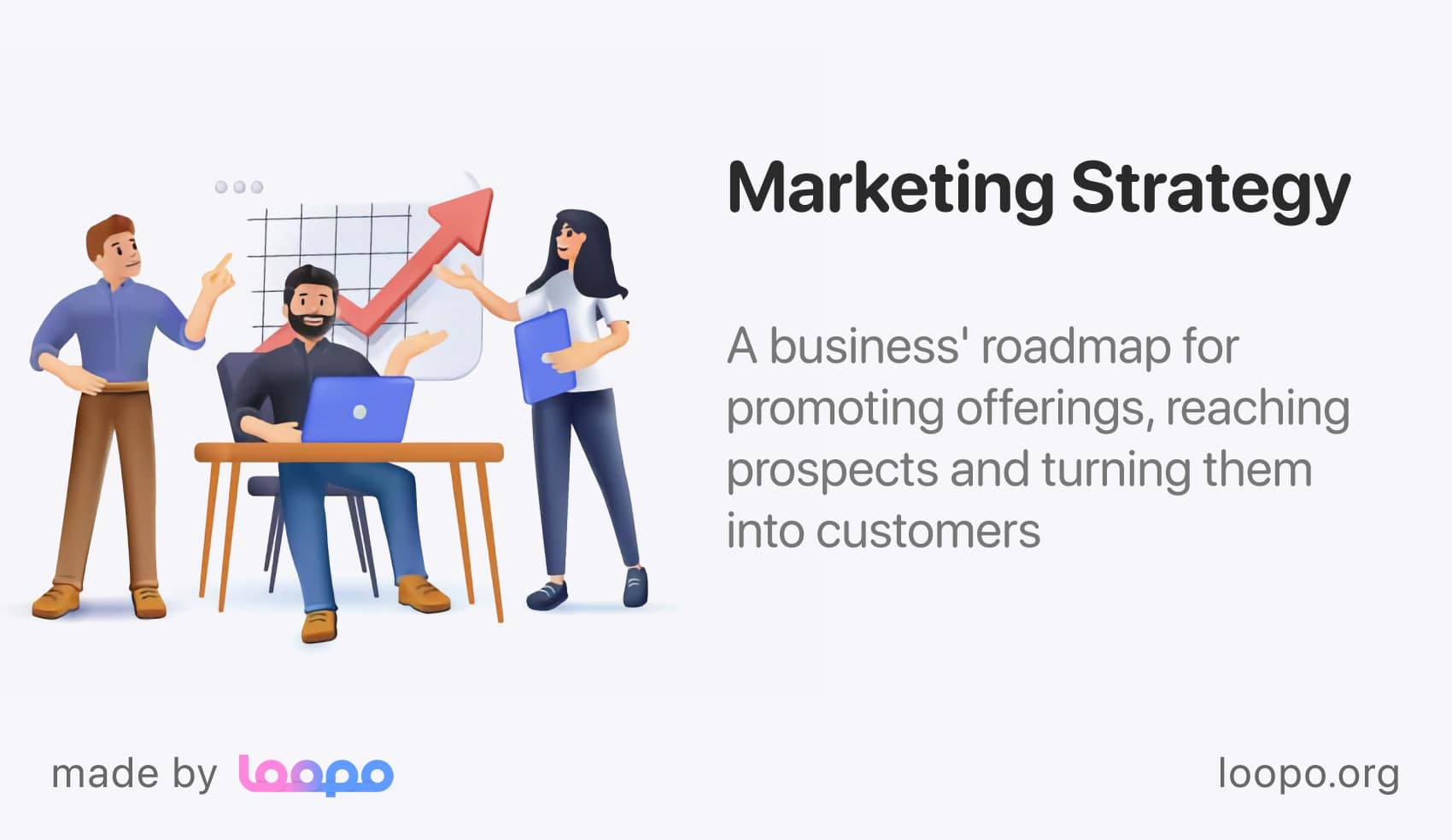
Think about it. Today, marketing offers a bunch of tools at your disposal, like advertising, social media, content creation, and more. With varying types of marketing strategy, you can decide which tools to use, when to use them, and how to use them in the best way possible. Moreover, with the right marketing team, you effectively delegate those tasks boosting the campaign’s performance and efficiency.
A detailed marketing strategy is a guide. It helps to make smart decisions about pricing, distribution, promotion, and positioning. Moreover, it helps to learn your customers’ habits, preferences, and dislikes.
11 Most Important Types of Marketing Strategies in 2024
Now that we defined a marketing strategy, we’re good to go! As mentioned, we’ll talk about types of growth strategy in marketing, differentiating them, and figuring out what they are precisely. As you know, marketing is kind of a broad term because it includes a myriad of aspects, each being essential in any marketing strategy. You can see them as cogwheels in a greater clockwork.
Hence, there are 11 types of strategies we will overview. Each of them covers different aspects of marketing. Let’s dive in, shall we?
1. Digital Marketing Strategy
The first one opening the list, is a comprehensive one. Digital marketing strategy focuses on everything that’s out there online. In simpler words, digital marketing strategies are created to promote services and products online.
As it is tailored to the online realm, digital marketing strategies normally have specific business goals. For instance, they may aim to boost sales and increase web traffic. But it’s also vital to know that digital marketing is a massive thing with different subcategories. Some of them are inherent to digital marketing only, and some can be applied out of its scope.
Yeah, it’s complicated, but you’ll understand, that’s a promise! For now, let’s stick to the digital marketing strategy and the subtypes that are inherent to it.
Type | Explanation |
Content marketing | This type is responsible for creating and distributing valuable and relevant content about the business. It includes blog posts, articles, videos, etc. It provides value to the audience while subtly promoting a brand or product, with the aim of building trust, establishing authority, and driving conversions. |
Email marketing | As the name suggests, it aims at creating targeted or personalized emails to subscribers. It nurtures relationships with users, promotes products, delivers valuable content, and drives conversions. Its campaigns can include newsletters, promotional offers, product updates, event invitations, etc. |
Search engine optimization (SEO) | It is responsible for promoting a website and optimizing its content. It takes care of it to improve its visibility in organic search engine results. It raises the overall visibility of your website in search engine results pages (SERPs). The most common practices are keyword research, link building, page optimization, and others. |
Pay-per-click advertising (PPC) | Following the model’s idea, advertisers pay a fee when the user clicks their ad. PPC can also refer to display advertising, social media advertising, or any other form of digital advertising where payment is based on clicks. Advertisers set bids and budgets, and their ads are displayed on relevant platforms to reach their target audience. |
Social media marketing (SMM) | It uses social media platforms to attract people, entertain and educate them on the one hand, and advertise products to them on the other. It includes creating compelling content, targeted ads, social media profile management, and interacting with users to drive engagement and conversions. |
Affiliate marketing | It is a performance-based marketing strategy. With its help, affiliates earn the commission they receive when promoting products or services on behalf of a business. Affiliates can be individuals or companies that promote products through various channels. When a user clicks on their unique affiliate link and makes a purchase, the affiliate earns a commission. |
Big, isn’t it? Don’t worry, it still does a great job explaining how wide and deep digital marketing is. You may have noticed that some of the strategy types were mentioned as a part of a digital marketing strategy. Indeed it is true, they may be present and play a vital role in a digital marketing strategy. However, they can also be used independently and that’s why we’ll cover them separately next.
2. Content marketing strategy
It's a way for businesses or individuals to share valuable and interesting information with their audience. Instead of directly advertising a product or service, a content marketing strategy creates content and shares it seasoning it with a bit of advertisement. Accordingly, people may find it helpful, entertaining, or educational.
By sharing information, insights, and tips, businesses not only provide value to readers but also build a relationship with them. Hence, sooner or later, people who are interested start following the blog or social media accounts to get more content. Over time, these followers become fans bringing credibility and trust to the table.
It may feel overwhelming at first, but you will figure it out! To give you an example, this article is also a part of content marketing strategy. This one and several others share valuable information that Loopo users may find helpful.
So, if you created, let’s say, a digital marketing agency and are looking to start your own content marketing strategy, identify the most critical steps. Let’s put them the way we do it, through questions.
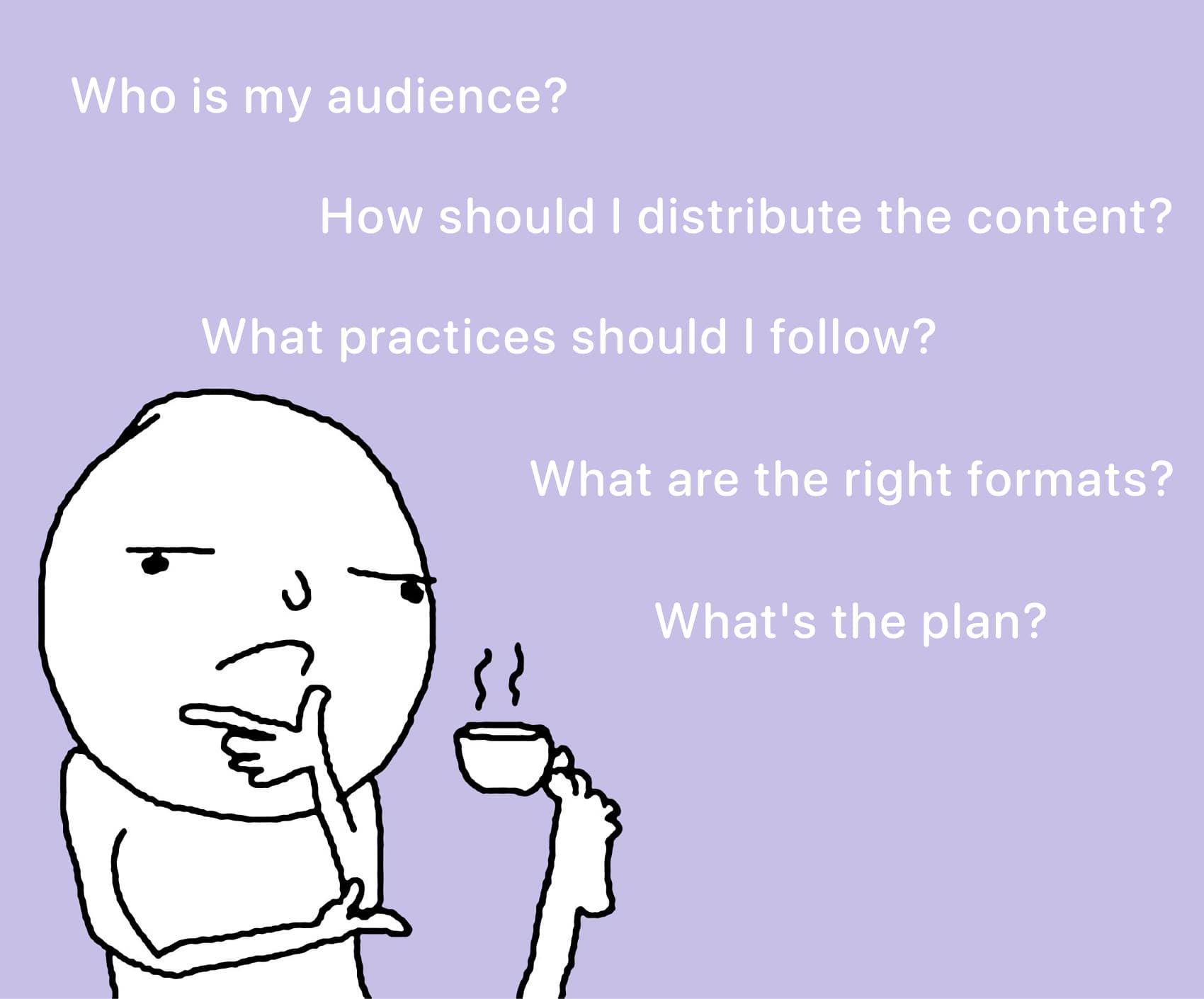
1. Who is your audience?
Knowing your audience is an advantage you can later use to establish a solid connection you will create. Find out the average age, occupation, gender, and other data of your users. This research will enable you to fit the content to their liking.
2. What are the right formats?
You can showcase value differently. Basically, it depends on what you offer. For some users, the best way to learn is through video guides, and for some – through extensive blog articles. Experiment with different formats and analyze which ones your users like the most.
3. How should we distribute the content?
You cannot do everything, and if so – it will be cluttered. Instead, choose a few channels, like a blog, Youtube guides, and several social media platforms. It will be more than enough to create a strong online presence. And remember to make a moderate choice based on the users' demographics from the first step.
4. What’s the plan?
In other words, figure out the posting frequency. Too rare posting doesn’t increase conversions neither does too frequent. Hence, for this, you can create short-term and long-term posting plans.
Do you know what may be of utmost help in such planning? Loopo task manager! With its help, you can easily schedule publications. Loopo allows you to create tags and categories for different types of posts, effectively manage and schedule them.

Moreover, with a built-in text editor, you can swiftly edit any post on the go! It has practically every feature you may need, even AI assistance to generate the idea in a time of dire need. After all, Loopo offers everything for a quick start with little to no distraction. Feel free to sign up in no time!
5. What practices should we follow?
There are plenty of those, for sure. Speaking of the most prominent ones, you can try AIDA. It is an acronym standing for Attention, Interest, Design, and Action. In a nutshell, it’s a four-step model that shows how to grab your users’ attention and deliver value to them.
Generally, there are many practices and frameworks you may find suitable. Feel free to observe but choose the one that aligns with your schedule, shares the same values, and simply feels natural.
Find out more: Empower Your Marketing Strategy: Unleashing the Potential of Marketing Frameworks
3. Inbound Marketing Strategy
Instead of relying on advertising and a kind of forceful attraction, the inbound approach relies on a natural user flow. The core principle of inbound marketing involves creating and sharing relevant and helpful content through various channels. After all, its goal is to establish the brand as a trusted authority and provide value to potential customers, positioning the business as a solution to their problems or needs.
You may wonder how inbound marketing strategy generates traffic if not because of ads? Here are some hacks that make inbound strategy work.
Lead nurturing. The inbound approach greatly emphasizes building relationships with leads over time through automated workflows, personalized content, and timely follow-ups. The goal is to guide leads, help them follow through the buyer's route, and lead them to make a purchase.
Search engine optimization (SEO). To naturally generate users and improve visibility, the inbound approach focuses on optimizing the content and website for search engines. This helps potential customers find the brand when they input specific keywords and phrases.
Conversion optimization. When users are engaged, marketing teams do their best to convert them into leads. For this, they use compelling call-to-actions, landing pages, lead magnets, and forms.
After all, here’s how it works.
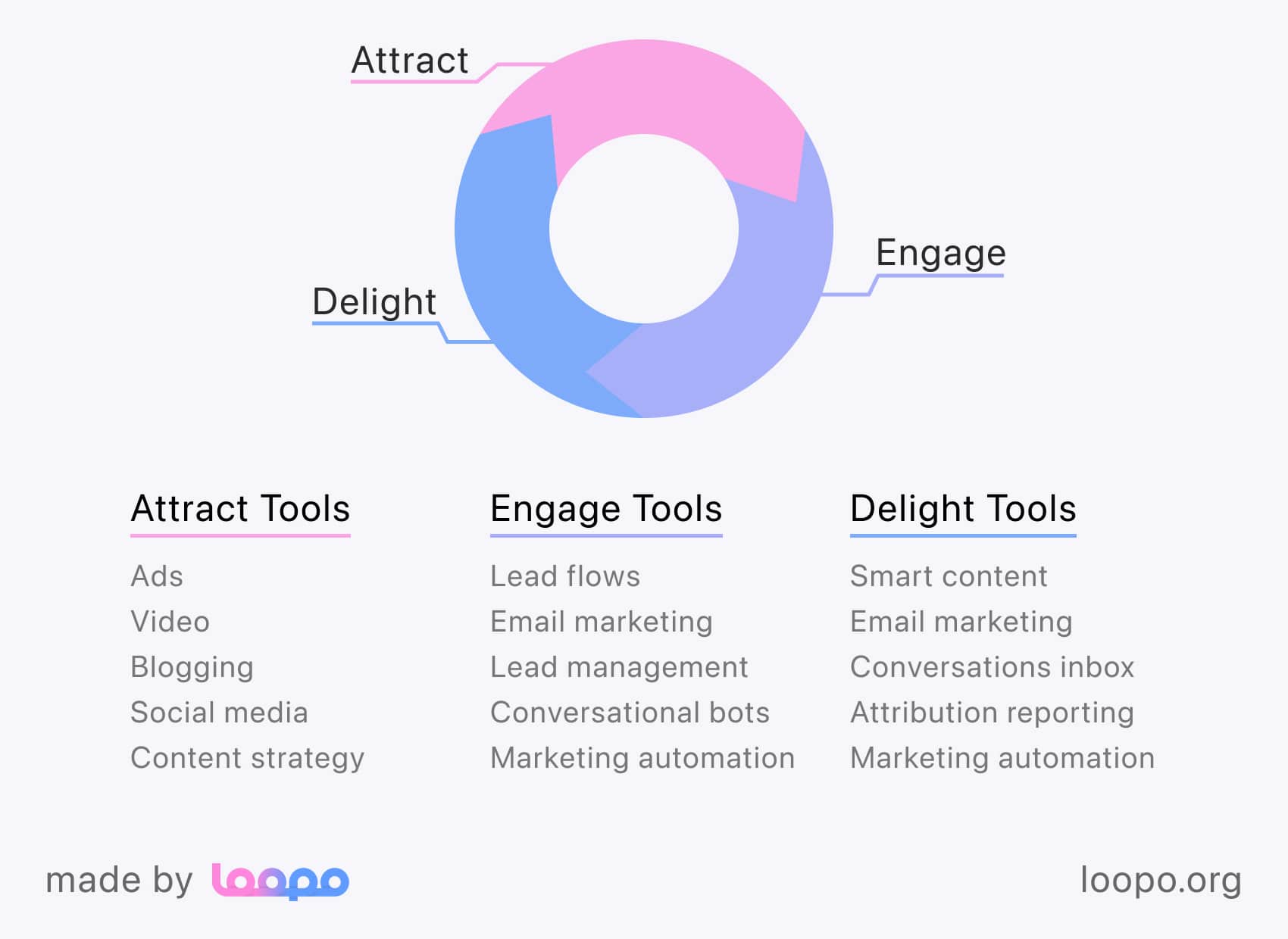
4. Social Media Marketing Strategy
It feels like this strategy doesn’t need a presentation. Still, social media strategy is one of the most common ones. At its core lies the idea of building a strong bond with users and promoting your brand through social media platforms like Instagram, LinkedIn, Facebook Behance, etc.
As of today, there are almost 6 billion active users on social media platforms, according to Statista. It is even scary to imagine how much time people spend there. Now imagine that literally, every user sees ads for certain products. So, what’s all the fuss about?
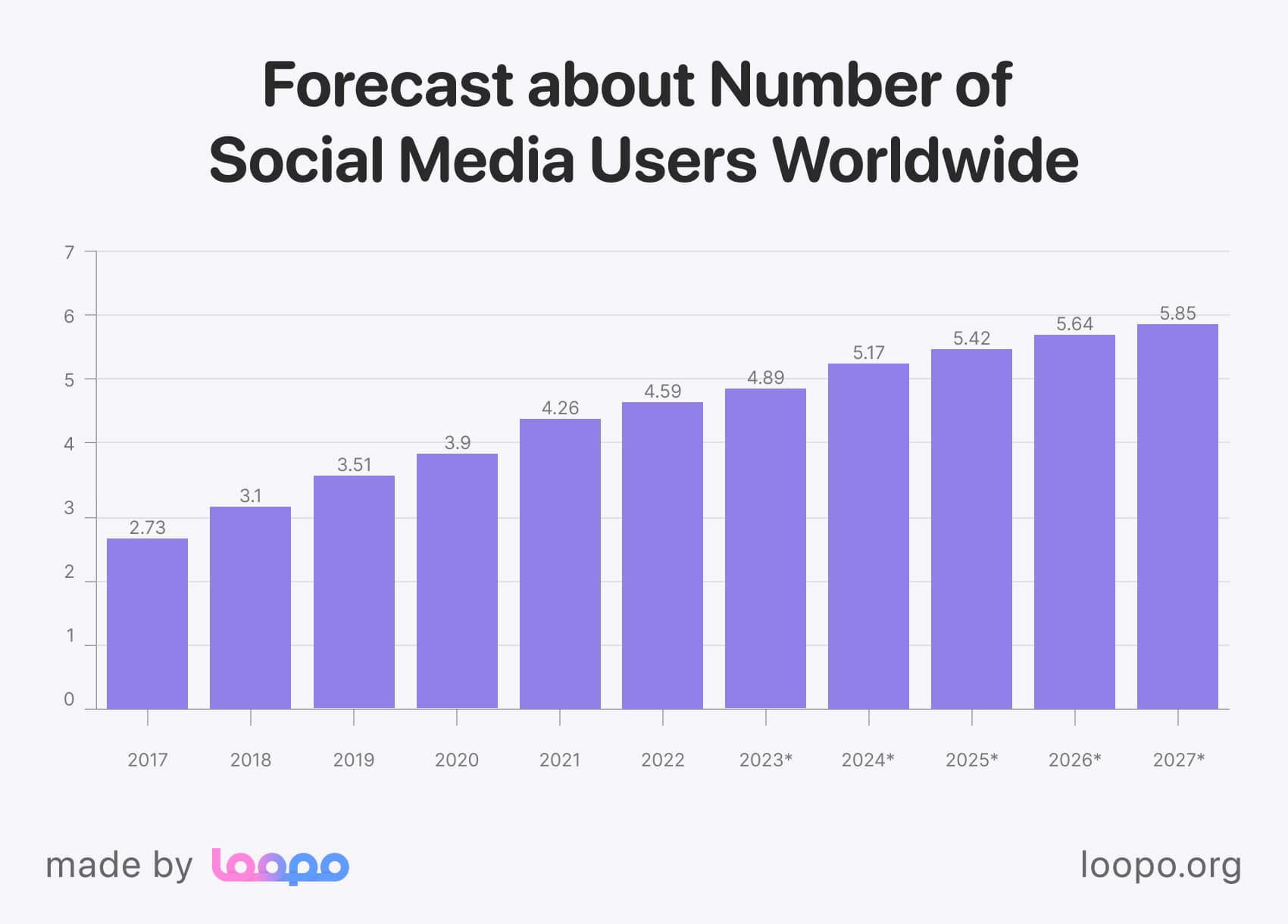
Social media platforms are massive and they provide extensive room for any type of business to build relationships with their clients. Today, social media platforms feel like a canvas where you hold all the paint and brushes. With such broad functionality, these platforms allow businesses to easily get into users’ daily routines and convert them into followers.
Moreover, social media now aren’t just platforms. They are huge databases that allow businesses to collect user-oriented insights, analyze their pain points, and so on. Hence, marketing teams take advantage of that, coming up with strategies to increase brand awareness, connect with people, educate or entertain them, and season the processes with goods/services promotions.
As you can see, with social media strategy, there’s a myriad of things you can do, as well as tutorials guiding you through every single step. Naturally, social media became so common in our lives that they themselves show us how to set up a strategy! Here, take a look!
Are you planning to focus on Instagram? Here, Instagram offers plenty of guides on how to set up ads on its platform in no time.
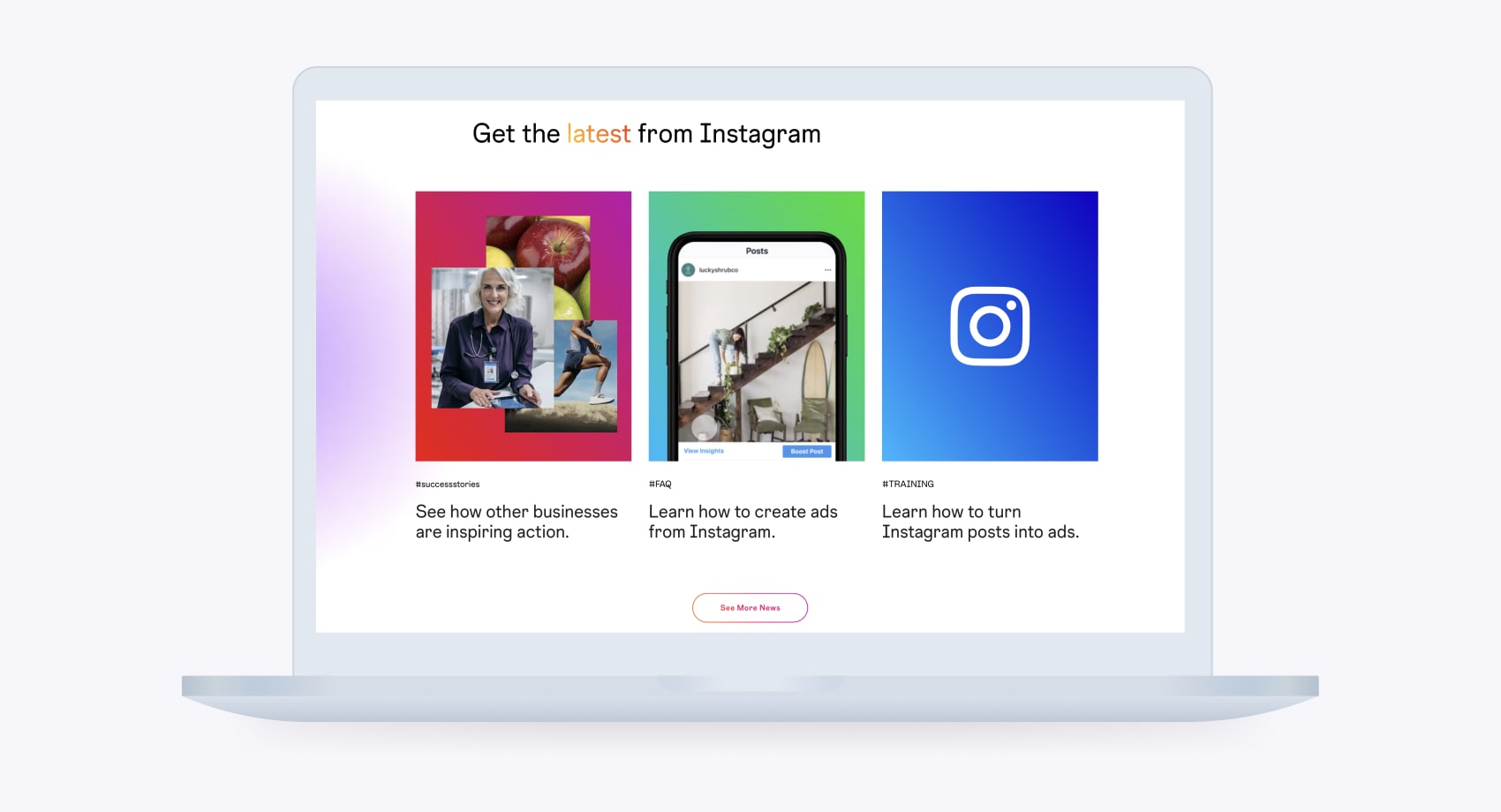
Well, maybe you think you should focus on Facebook? No worries, Facebook offers plenty of material to start it in neat steps.

Still don’t believe us? Really, even LinkedIn team shares more than enough info to get started and make it efficient!

Instead of saying that one nasty “wE ToLd YoU,” we’ll summarize. As you can see, social media marketing is indeed a huge thing, with plenty of room to start your own strategy. All you need to do is get interested, and we hope we managed to awaken that curiosity.
5. PR marketing strategy
First of all, PR stands for Public Relations strategy. A PR marketing strategy refers to the strategic planning and implementation of activities aimed at promoting and managing a company's reputation and public image.
In PR marketing strategy, marketers use various communication channels and tactics to build positive relationships with the target audience, including customers, stakeholders, and the general public.
The ultimate goal the PR marketing strategy follows is to enhance brand visibility, credibility, and trustworthiness, thus supporting the overall marketing objectives of the organization.
PR strategy is a bit different from others. Apart from regular marketing tricks, here’s what marketers do to make this particular strategy effective.
Storytelling
By letting people know what your brand is all about in a unique and consistent message, you can effectively share your values and mission.
Strong media presence
By partnering with bloggers, journalists, or thought leaders you make your brand more recognizable, let’s say, put it in the spotlight. So, the strategy promotes sending out press releases, hosting cool events, and sharing your expertise to get some awesome media coverage.
Team up with cool influencers
This strategy highly relies on teaming up with known people. With influencers and industry experts in place, you can greatly increase your brand's reach. You can let them guest blog for you or have them endorse your products.
6. Influencer Marketing Strategy
This strategy is a really cool way to promote a brand, product, or service by teaming up with popular and influential individuals known as influencers. But who are they?
Well, they’re popular people whose thoughts people listen to and adhere to. Normally, they have a massive audience and are able to project their thoughts (and paid advertisements) to create trends and demand.
They can be categorized by the types of content they produce. The most popular are 4:
Bloggers;
Youtubers;
Podcasters;
Social media posters.
Moreover, they can be divided into 5 so-called ‘tiers’. Usually, they are formed depending on the number of active subscribers they have.
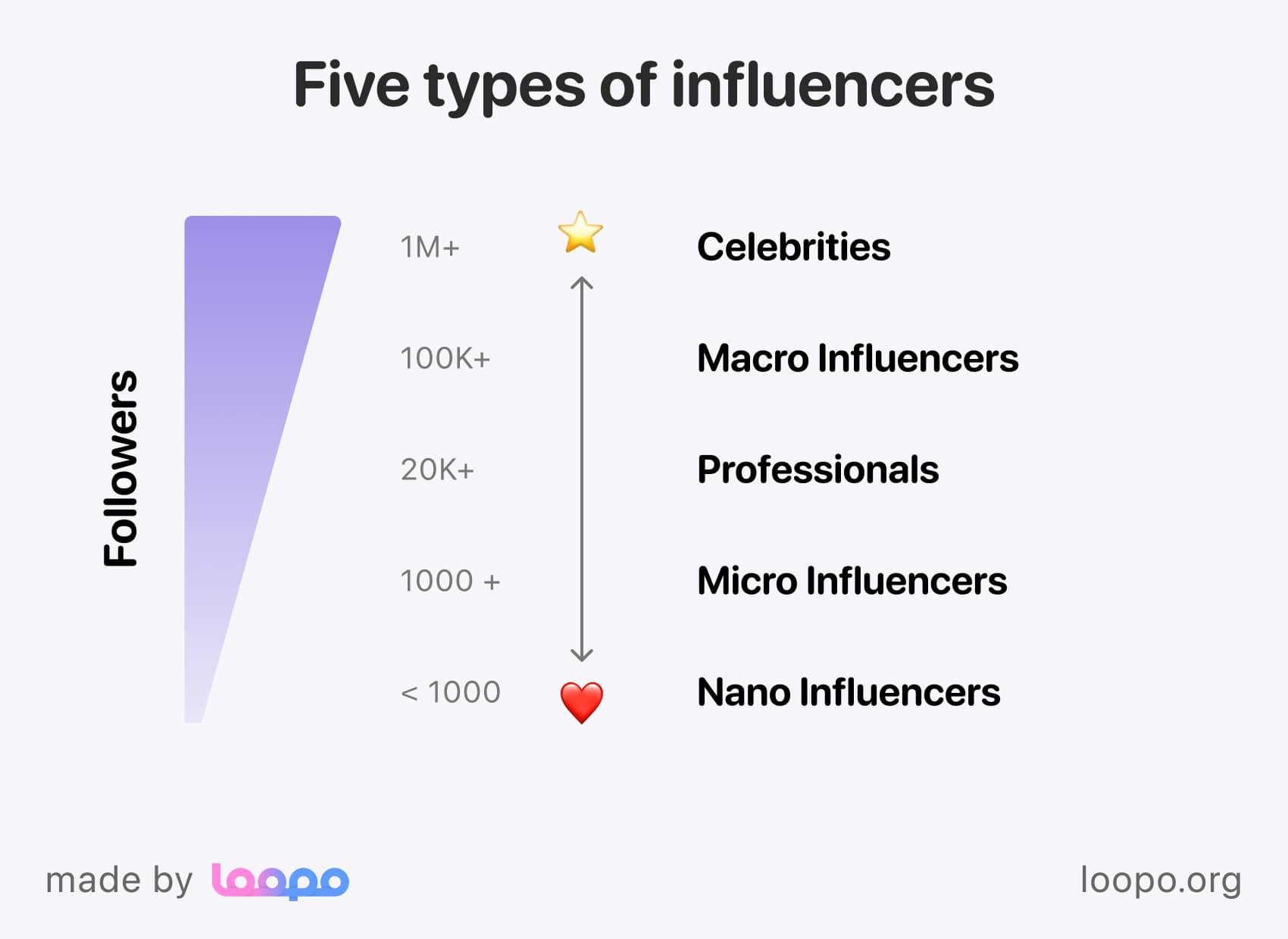
- Celebrities. These are people we all know. They have huge audiences (above 1 million subscribers) and are known to be expensive as hell. However, they have access to a massive audience.
- Macro influencers. These are trusted stars with a big audience (above 100K). They can effectively project info and typically are more accessible than celebrities.
- Professionals. This category is a middle ground with above 20K subscribers. Normally, it consists of journalists, scientists, business leaders, and simply people who are professionals in a certain niche.
- Micro influencers. Influencers in this category normally have above 1000 subscribers and are common in narrow niches and focused networks. Still, they’re a great choice if you operate in such a niche. Moreover, their advertising is more than affordable.
- Nano influencers. With below 1000 subscriber count, these people are simply passional brand advocates. Their operational area is more tied to a location and niche.
Now back to the strategy. So, how does the entire influencer marketing strategy work? Well, first, you choose the person whose agenda and interests align with your values. Then, you figure out the audience whose attention you need to catch and then simply research for the right candidate!
Basically, you collaborate with these awesome influencers to create sponsored content that showcases your brand in a positive light. They can create posts on social media, videos, blog articles, or even host fun events to engage with their followers and spread the word about your amazing stuff.
7. Email Marketing Strategy
This strategy is not just a subset but an incredibly powerful way to connect with potential customers and build strong relationships with existing ones, all while being cost-effective. Following the name, the idea is advertising through email campaigns.
Today, there are lots of tools you can take advantage of to create a compelling email marketing strategy. Let’s take a look at 3 of our beloved ones.
HubSpot
It is an all-embracing platform that has numerous features for you to benefit from. Hubspot has a great email constructor, native CRM integration, and a lot of room for A/B testing. Take a look, isn’t it alluring?

- Mailchimp
This platform is the best overall. It is a perfect fit for startups, small businesses, and even grand companies. With Mailchimp’s help, you can easily set up a strategy, track its performance, and set automation. Here, look, it really offers a lot!

- Drip
It is a fast-growing platform that emphasizes extensive email automation and makes them easy as a stroll in a park. With Drip, you can learn a lot about email marketing, listen to their podcasts, and master the art of creating a compelling email marketing strategy.

Now, when it comes to crafting your email marketing strategy, there are a few friendly tips to keep in mind.
First things first, make sure your email list is accurate and up to date. You don't want any outdated or incorrect email addresses causing undeliverable emails. That could harm your reputation and, even worse, lead to losing valuable customers.
Next up, don't forget to segment your email list. This means dividing it into smaller groups based on certain criteria. By doing so, you can send personalized messages that truly resonate with each specific group. This way, you’ll help your recipients feel special and cater to their interests.
Lastly, stay open to experiments, and try out different email strategies. What works best for your business and customers might not be the same as what works for others. So, don't be afraid to test the waters and find the approach that brings you the most success.
8. Paid Advertising Strategy
Just like any other strategy, paid advertising is a fantastic marketing tool that allows businesses to get their products or services noticed. In a nutshell, this strategy is about investing in various forms of promotion, like sponsoring websites and online events, paying for search engine placements, etc. With its help, you can effectively reach a large audience and deliver a focused message. It's an essential part of any smart marketing strategy.
Speaking solely of the platforms, there are plenty of them to choose from.
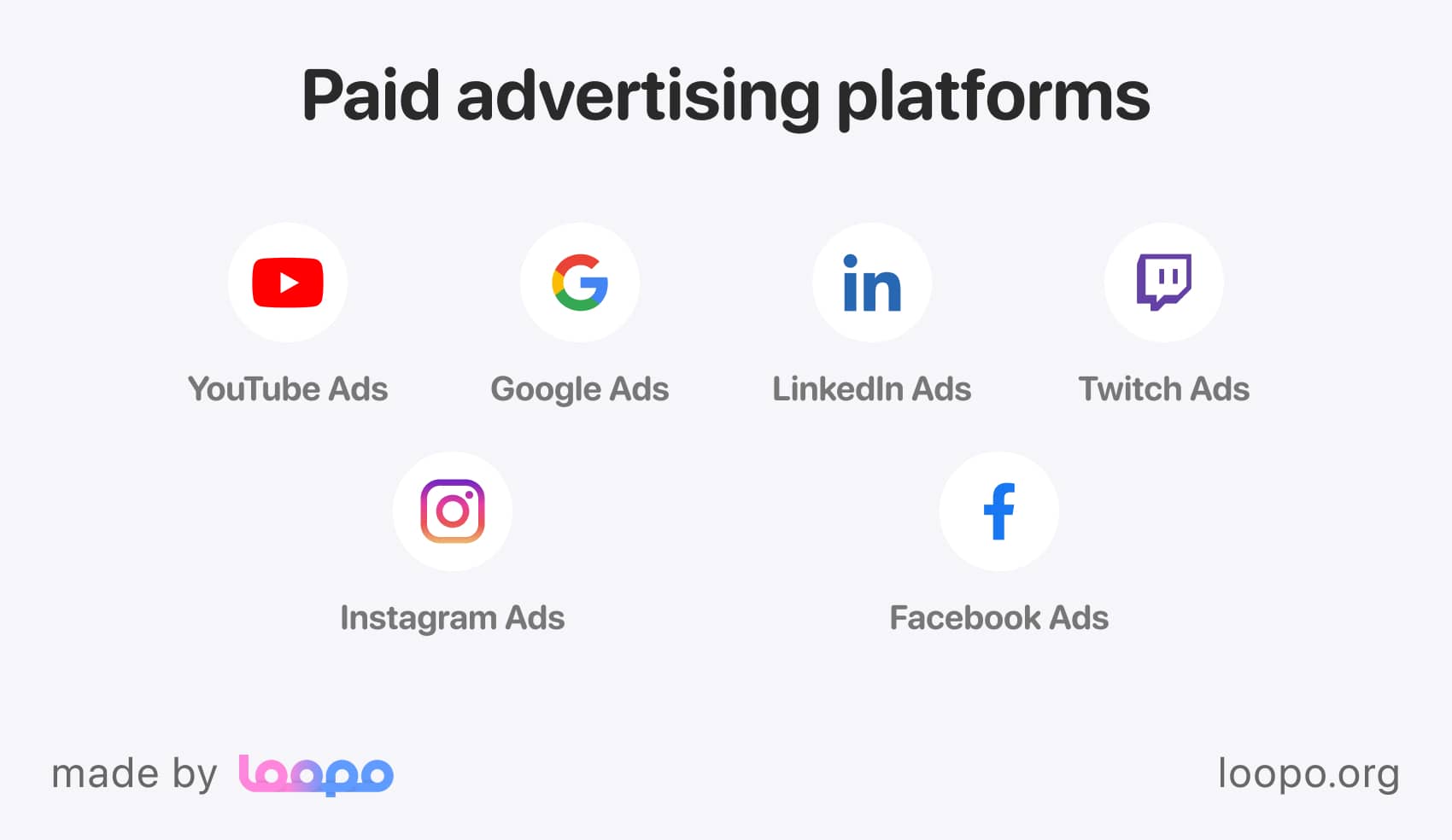
- For instance, if you target search engines, you would normally turn to Google Ads and populate SERPs with your advertisements.
- If you plan to share your presence along social media, it’s always a good idea to research Facebook Ads, Instagram Ads, Twitter Ads, and LinkedIn Ads.
- If you’re planning to cover an even wider audience, you could make use of display advertising. With Google Ads help, you can place visual ads, such as banners or interactive ads, on websites or mobile apps.
- When you build a solid presence on video streaming platforms, YouTube Ads is always a good option. Moreover, you can also think of TikTok ads, Twitch Ads, or even partnering with streamers that appear as influencers.
9. SEO strategy
If you are a lucky owner of a really awesome website or blog, then SEO strategy is the ultimate you need. It's a way to improve your website's visibility on search engines. When people google something, search engines try to show the most relevant and valuable results. SEO specialists, in turn, analyze the keywords people use and enhance your website with them. As a result, when people look something up, they are more likely to see your page among the most relevant ones.
Curious already? Here are key steps to take to set up a sturdy SEO strategy.
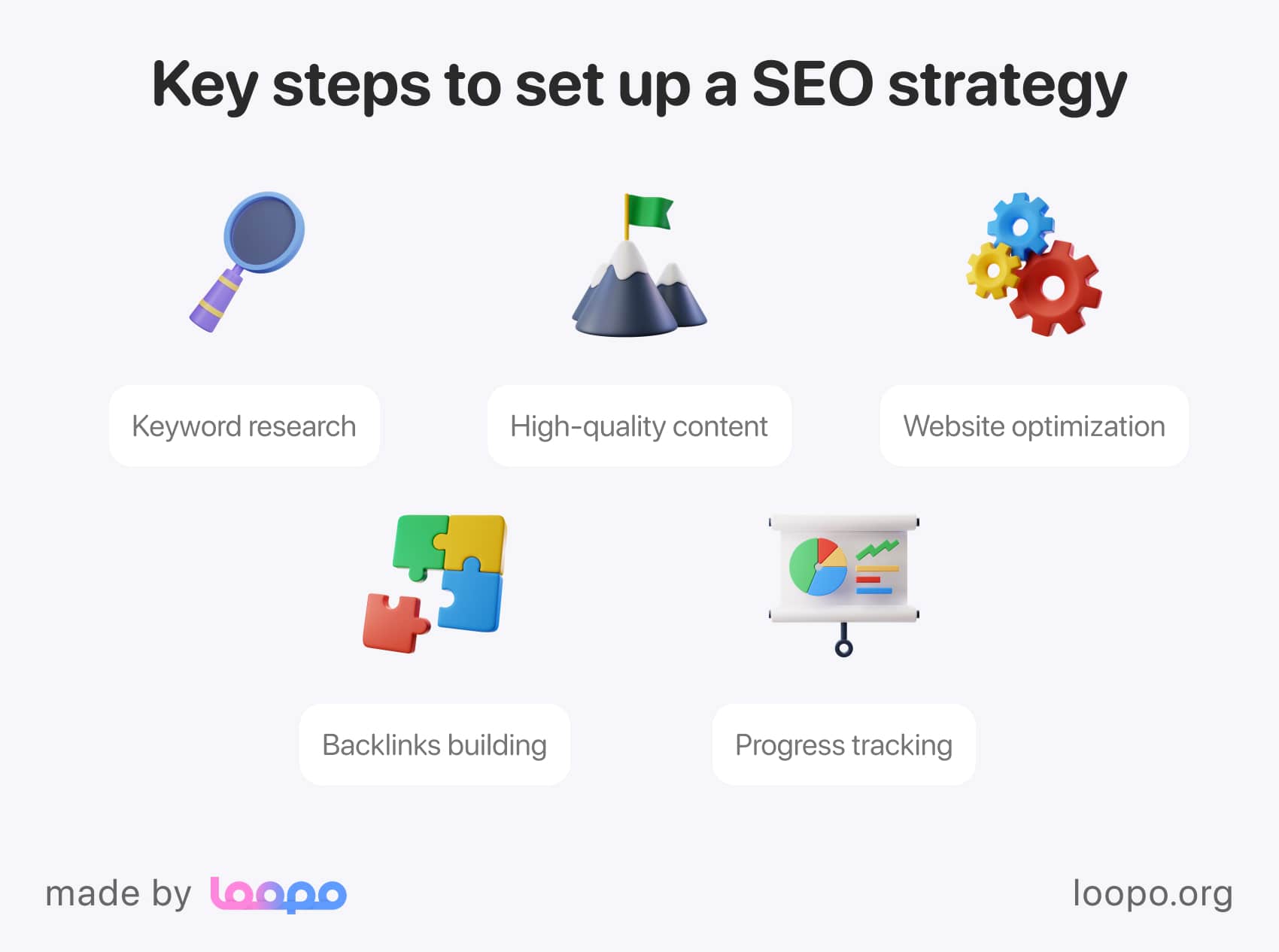
- Keyword research is a core. SEO specialists analyze the most used words or phrases people might use when searching for content related to your website. By researching these keywords and populating your content with them, you can boost views and attract the right audience.
- Create high-quality content and optimize it for your target keywords. Your content should be well-written, relevant to your target keywords, and simply engaging. It should also be well-structured and easy to read.
- On-page optimization process. This involves optimizing your web pages by using your chosen keywords in strategic places like the page title, headings, and throughout the content. It also includes making sure your website is easy to navigate and loads quickly.
- Build backlinks to your website. Getting other reputable websites to link to your content is like a vote of confidence for search engines. It makes your website or pages shine with credibility and trustworthiness. Building relationships and contacting other websites or blogs in your industry can help you earn these backlinks.
- Track your progress and take time to make adjustments. As always, it's important to track your strategy’s performance. For instance, you can use a tool like Google Analytics to track your website traffic, SEO rankings, how many new visitors you get, etc.
10. Marketing communications strategy
Normally, this type of strategy companies use to talk to people about their products or services. It's all about finding creative and effective ways to share messages that catch people's attention and make them interested in what the company has to offer.
To create a successful marketing communications strategy, companies first come up with cool and catchy messages that show off their brand and explain why need what the company offers. They want to make sure these messages are easy to understand and make people excited to learn more.
Essentially, building a communications strategy is about finding the right tone of voice, and the right people to present the company. Speaking of examples, imagine two world-known cases.
On the one hand, we have Nike, the world's most-known sports brand. They have stories – blog articles where they raise numerous topics. Some are about athletes’ thorny paths, and some are about inspiring initiatives to make the world a better place.
In the case of Nike, they emphasize solidity and determination. Hence, they use a confident tone of voice and avoid any jokes and jargon. Thus, Nike leaves a lasting impression and inspires readers in their own way.

On the other hand, let’s take a look at Fortnite. It is an award-winning game that conquered the hearts of millions all over the world. What’s up with their communication? Well, it’s friendly, to say the least. In their communications, the Fortnite marketing team never indulges jokes, rhetorical questions, catchy titles, and funny fonts to capture the interest of the reader.
No wonder, their main task is to attract people to play the game, try new updates, purchase in-game items, etc. Given the idea that their main audience is gamers of all ages, they have just the right approach. Essentially, this strategy is all about getting people excited!

11. Traditional Marketing Strategy
Last but not least, traditional marketing strategy is the very root of all previous strategies we talked about. Traditional marketing is the OG of marketing!

Hence, it presents the good old-fashioned ways to reach people in the real world. Marketing pros use traditional marketing to connect with their audience in physical places where they hang out. The entire idea is to get users’ attention in places where they are most likely to see, hear, or interact with these marketing materials.
Think about those catchy jingles on the radio that make you sing along or the funny commercials on TV that you can't help but watch. Those are examples of traditional marketing! And who can forget those massive billboards along the highway that catch your eye as you zoom by? Apart from these, there are other means of traditional marketing.
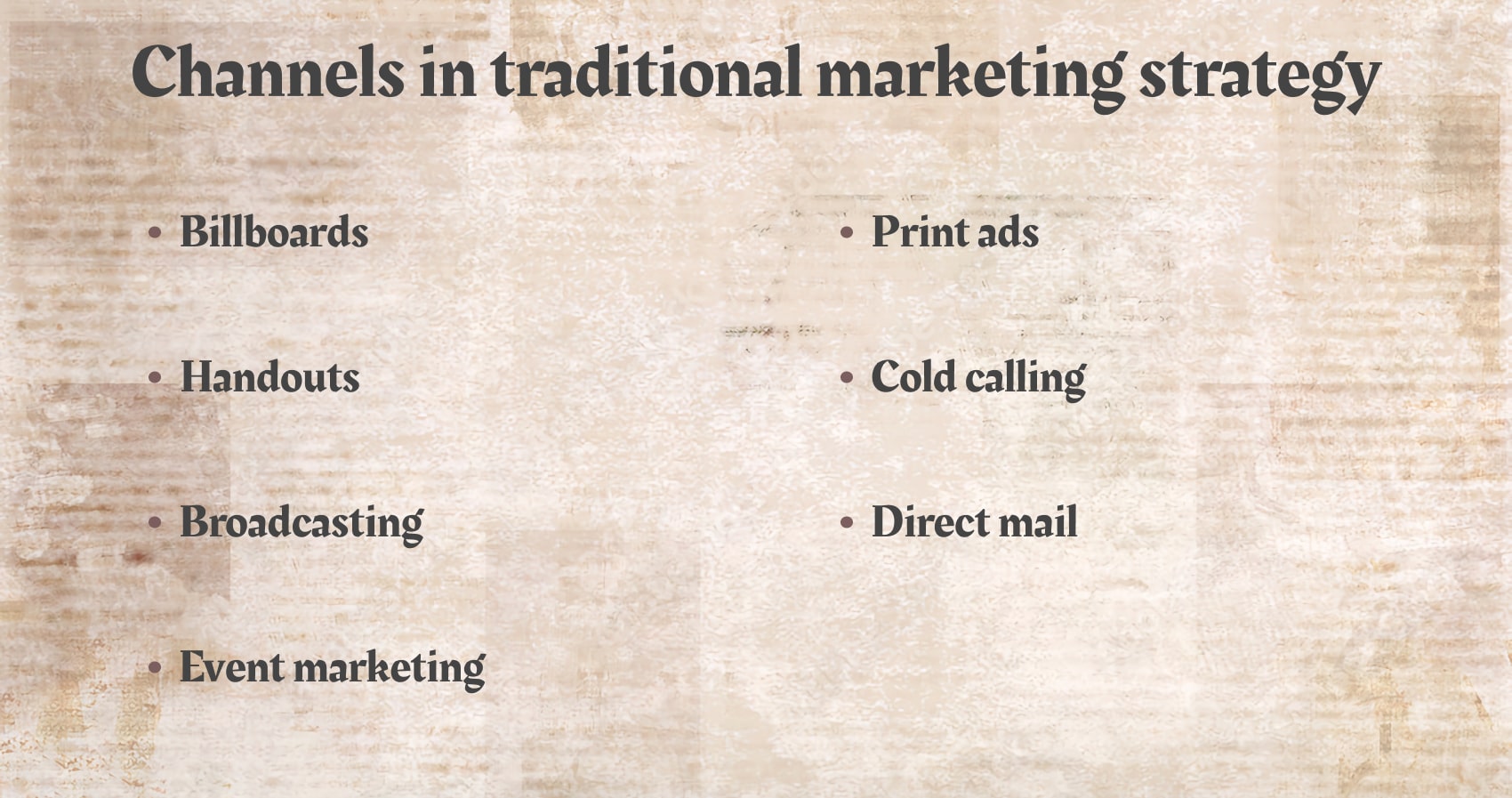
- Handouts. These represent good old brochures and flyers that promote. Sometimes they share a word about upcoming sales, discounts, new locations, etc. Typically, they include the physical address of the business, contacts, and how to find the business online.
- Broadcasting. Back at the time, these were considered premium, as being promoted on the radio or TV used to cost a lot. Still, it’s a popular way to get recognition. However, radio and TV are quickly getting changed with podcasts, YouTube videos, and Twitch streams.
- Print ads. They typically appear in magazines and newspapers and are common within certain ranges of people. Again, back in the day, it used to be a thing, but now it is mostly boiled down to advertising local services.
- Event marketing. This category includes all marketing materials that can be shared at offline events, lectures, meetings, etc. Huge signs, banners, and even booths are typical attributes of event marketing.
- Direct mail. This approach is still around and you see it daily! Have you seen all those postcards and printed ads your inbox is filled with? It is thanks to direct mail. Most of the time, they are random and simply promote businesses that are close to you.
- Cold calling. With the rise of security concerns, you can rarely receive a cold call today. However, it is a very preferable way for B2B or B2C companies to promote their things, notify about sales, etc. All it takes for them to set up is to obtain your phone number once when you register for some kind of loyalty program. Then, they collect a database of numbers and simply call people to find anyone interested.
Conclusion
And here we are, at the very bottom of this extensive piece. Looking back, we discussed a lot about the eleven most popular marketing strategies. As you can see, they are different and, thus, suitable for various cases.
Each of the strategies we listed are great tools. In the right hands and mindful approach, they can do wonders with your brand, audience, and sales. After all, we sincerely hope their detailed description, use cases, and examples will be of great help in your way.




